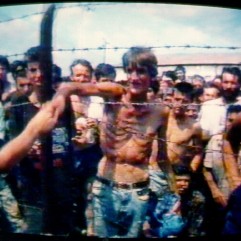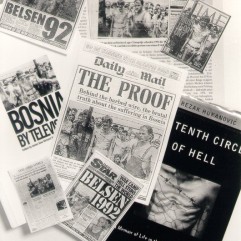In Zwitserland zit een heel zorgvuldige organisatie: Swiss Propaganda Research.
Ik ben het niet altijd met ze eens als ze over Rusland schrijven, maar wat betreft Yugoslavië hebben ze de definitieve analyse gemaakt:
Propaganda in the War on Yugoslavia
Published: December 2019 (upd.)
Languages: EN, DE
Languages: EN, DE
The war on Yugoslavia in the 1990s essentially was about restructuring Southeast Europe after the end of the Cold War. To achieve this goal, the US even deployed the combatants with which it had previously fought the USSR in Afghanistan and which it would later call „Al Qaeda“.
The political and media propaganda regarding the war on Yugoslavia has been well researched. Interestingly, however, many media outlets and commentators are still trying to uphold the official narrative of the time, in contrast to the later war in Iraq, for example.
There may be various reasons for this. On the one hand, the propaganda in question dates back to the early days of the Internet and is therefore generally less well known to the public. On the other hand, the implications, notably for Europe, are particularly far-reaching in this case.
From today’s perspective, it is of course a trivial statement that most Western media outlets supported NATO’s war on Yugoslavia, but at the time even critics believed in a media „failure“, especially because the influence of foreign policy groups was not yet broadly known.
The following sections provide an overview of propaganda in the war on Yugoslavia as well as references to further literature and documentation. Please note that the analysis does not question any actual war crimes on any side of the conflict.
1. The Serbian »Death Camp« (1992)
One of the most notorious cases of propaganda in the Yugoslavia war is the alleged Serbian death camp of Trnopolje in Bosnia. The story began in August 1992, when three British journalists visited a refugee camp whose inmates stressed that they were being treated very well (see video below).
The journalists, however, went to a fenced off storage area right next to the refugee camp and filmed the men through a barbed wire fence, making it appear as if the men were imprisoned, which in fact they were not (see site map below). The journalists then asked a man emaciated from illness or war-related malnutrition to take off his T-shirt.
The resulting photograph – carefully cut to size – landed on the front pages of most Western media as „proof“ of Serbian „death camps“, which in turn served as justification for NATO’s subsequent intervention in Bosnia, starting with a no-fly zone.
The Trnopolje death camp deception was exposed by a German journalist in 1997. A British magazine that republished his article got sued by the three British journalists for libel and eventually lost the case because it couldn’t prove their intent.
The head of an American PR agency that had spread the false death camp reports later explained: „We are professionals. We had a job to do and we did it. We are not paid to be moral.“
See also: The original article exposing the „death camp“ deception (Thomas Deichmann, 1997)
Watch full documentary: Yugoslavia: The Pictures that Fooled the World (2000)
TV screenshot, press headlines and site map of the Trnopolje refugee camp
2. The Sarajevo Marketplace Massacres (1992-1995)
Another well-known case of propaganda concerns the the so-called marketplace massacres in Sarajevo, in particular the so-called bread line massacre of May 1992 and the two so-called Markale massacres of February 1994 and August 1995.
These massacres took place by grenade fire or bomb explosions and often happened shortly before important political consultations at the UN or EU. They ultimately led to a direct military intervention by NATO – the first in its history – and thus to a turnaround in the Bosnian war.
In the cases mentioned above as well as some others, investigations by officers of the UN Protection Mission came to the conclusion that these massacres had probably been perpetrated by the Bosnian side on its own population (so-called false flag attacks).
The relevant UN reports, however, were kept secret. Instead, American media — especially CNN — and the US government usually claimed within a few hours that the respective attack had presumably been carried out by the Serbian side.
In the following you will find the most important articles from that time by journalists who were able to study the unpublished UN reports or talk to officials involved in writing them:
- Bosnia bread queue massacre was propaganda ploy, UN told (Independent, 1992)
- Dateline Yugoslavia: The Partisan Press (Peter Brock, Foreign Policy, 1994, archived)
- Anatomy of a Massacre (David Binder, Foreign Policy, 1994, archived)
- Bosnia’s Bombers (David Binder, The Nation, 1995, archived)
- Senior official admits to secret U.N. report on Sarajevo massacre (DPA, 1996, archived)
- 2004: Sarajevo massacre remembered (BBC; see quote by General Michael Rose)
Twenty years later, the Bosnian Markale massacres of 1994/95 were recalled when poison gas attacks during the Syrian war turned out to be staged and the results of UN and OPCW investigations were again suppressed to justify military strikes by NATO countries.
3. The »Genocide of Srebrenica« (1995)
The „Genocide of Srebrenica“ in July 1995 is regarded as the sad climax of the Bosnian war. According to Western sources, more than 8000 Bosnian civilians were killed.
In this case too, however, the actual evidence points to a more complex situation and a somewhat different context. Even Phillip Corwin, the highest ranking civilian UN representative in Bosnia during the war, rejected the official Western account of events in Srebrenica.
The late political scientist Edward S. Herman and the former CIA officer Robert Baer, who was operating in Yugoslavia during the war, even spoke of a „fraud“ in this regard.
For further details, please refer to the following articles and documentaries:
- The Politics of the Srebrenica Massacre (Edward S. Herman, Global Research, 2005)
- Srebrenica Revisited (Diana Johnstone, Counterpunch Magazine, 2005)
- Srebrenica: A Town Betrayed (Norwegian documentary, 60 minutes, 2010)
- The Srebrenica Massacre: Evidence, Context, Politics (Edward S. Herman, ed., 2011)
- Evacuation Of Srebrenica Refugees (Original footage of July 12, 1995)
In general, even events with very high reported victim numbers must sometimes be critically examined. This was shown, for example, by the „Timisoara Massacre“ of 1989 with allegedly 4630 dead, which later turned out to be a psychological operation to launch the Romanian revolution.
Srebrenica: A Town Betrayed (Norwegian documentary, 60m, 2010, Wikipedia)
4. Kosovo: »Operation Horseshoe«, Račak and Rogovo, and more (1999)
After the separation of Slovenia, Croatia and Bosnia from Yugoslavia, the US and NATO started another war in 1999 against the remainder of Yugoslavia to additionally separate the province of Kosovo from Serbia. This war again had to be justified by propaganda and disinformation.
In particular, politicians and the media mentioned alleged expulsion plans, concentration camps and massacres, which later turned out to be invented or questionable. Examples include the alleged „Operation Horseshoe“ (to expulse Albanians) and the incidents at Račak and Rogovo.
In the case of Račak, for instance, Finnish forensic experts concluded that the bodies of KLA figthers killed in action had been moved, redressed, and presented as civilian victims of an execution.
The head of an American public relations agency that had spread such dubious stories about the situation in Kosovo later stated in an interview: „To be honest, when NATO finally attacked in 1999, we opened a bottle of champagne.“
For further details, the German documentary „It Began with a Lie“ from 2001 will be shown below (English subtitles available). The documentary shows how Western politicians and military men deliberately published false information in order to legitimize the war.
See also:
- Meet Mr. Massacre (Mark Ames and Matt Taibbi, The Exile, 2000, archived)
- The hoax that started a war (Peter Worthington, Toronto Sun, 2001, archived)
- Serbian ethnic cleansing scare was a fake, says general (Sunday Times, 2000, archived)
- Media Cleansing: Dirty Reporting. Journalism and Tragedy in Yugoslavia (Brock, 2006)
- The Dismantling of Yugoslavia (Herman/Peterson, Monthly Review, 2007)
Kosovo War: It Began with a Lie (WDR documentary, 2001)
See also
- The American Empire and Its Media (SPR, 2017)
- The Logic of US Foreign Policy (SPR, 2018)
- Rwanda: What did really happen in 1994? (SPR, 2019)



No comments:
Post a Comment